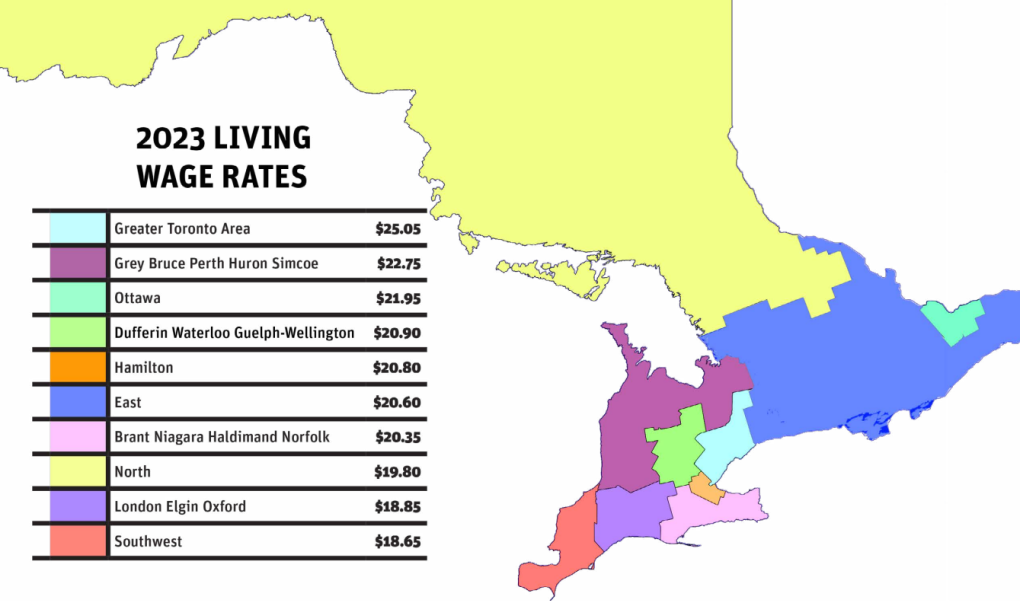New living wage rate released for Waterloo Region and Wellington County
Workers in Waterloo Region and Wellington County need to earn at least $20.90 per hour in order to make a living wage, according to a new report from the Ontario Living Wage Network (OLWN).
That’s up 95 cents from last year and well above Ontario’s minimum wage of $16.55.
 Fresh produce and groceries are shown at Summerhill Market in Toronto on Wednesday February 2, 2022. The Ontario Living Wage Network says food costs are one of the highest expenses in the living wage calculations. (THE CANADIAN PRESS/Frank Gunn)
Fresh produce and groceries are shown at Summerhill Market in Toronto on Wednesday February 2, 2022. The Ontario Living Wage Network says food costs are one of the highest expenses in the living wage calculations. (THE CANADIAN PRESS/Frank Gunn)
The provincial government upped the minimum wage by 6.8 per cent last month. But even with that measure, “there is still no place in the province where someone could make ends meet working full-time at this wage,” the OLWN said in the report.
In order to calculate the living wage, the OLWN looks at the expenses for three types of households: single adult, single parent with a seven-year-old child, and a family of four, with children aged seven and three.
It factors in costs like food, rent, transportation, clothing and footwear, medical expenses, childcare, adult education, internet and cell phone bills and other expenses like recreation and personal care. It also includes any applicable government taxes, transfers, and benefits.
“A living wage is an effective tool to combat working poverty by making sure that employees can make ends meet where they live,” OLWN said, adding it also considers expenses related “to more than just surviving” like a modest vacation and opportunities for residents to engage with their local communities.
 (Source: Ontario Living Wage Network)
(Source: Ontario Living Wage Network)
'A VERY REALISTIC REFLECTION'
The Region of Waterloo is among 625 certified living wage employers across the province.
The region said it's worth paying the difference in order to give its roughly 4,000 workers peace of mind.
"I think it's a very realistic reflection of the cost of living and the cost of being able to provide for your family," said Regional Chair Karen Redman.
According to the OLWN, most living wage employers can keep up with the yearly increases.
"Of our 635 employers, only a small handful have ever had to back away because the increase was not manageable. They build it into their business model and track the increases," said Craig Pickthorne, communications manager with OLWN.
LOCAL BUSINESS REACTION
The concept of paying employees a living wage is far from odd at one Kitchener establishment.
"We've actually found that staff engagements have been way bigger here than any other place we've ever worked," explained Jon Rennie, the culinary director at the Odd Duck Wine & Provisions.
The restaurant is a living wage employer and since opening their doors this summer, owners say paying employees a bit more but not accepting tips, has been extremely positive.
"They were tired of the tip system and having their wages decided on the whims of this and that person," said Rennie. "Our pricing is not really very much out of line compared to other restaurants of the same kind of calibre within the area."
Rennie added that customers tend to gravitate towards the idea and come back partially because of it. Employees also feel less stress.
"It's the first time I enjoy coming to work. I know that I'm secure," said Mona Mousa, the social media manager for the restaurant. "I love the environment here. Everyone genuinely enjoys working with each other because we don't have those external stressors. We can really focus on the energy."
With file from CTV Toronto
CTVNews.ca Top Stories

Police arrest Toronto woman in connection with three recent homicides
Police have arrested a Toronto woman in connection with three recent homicides and investigators say that they believe two of the victims may have been 'randomly targeted.'
NDP house leader laments 'agents of chaos' in precarious Parliament
NDP House leader Peter Julian says there's more his party wants to do in Parliament before the next election, but if the current dysfunction continues it will become a factor in how they vote on a confidence measure.
Former Colorado county clerk Tina Peters sentenced to 9 years for voting data scheme
A judge ripped into a Colorado county clerk for her crimes and lies before sentencing her Thursday to nine years behind bars for a data-breach scheme spawned from the rampant false claims about voting machine fraud in the 2020 presidential race.
Youth pleads guilty to manslaughter in death of P.E.I. teen Tyson MacDonald
A teen charged with the murder of another teen on Prince Edward Island last year has pleaded guilty to a lesser charge of manslaughter.
Jury begins deliberations in Jacob Hoggard's sexual assault trial
The jury tasked with determining if Canadian musician Jacob Hoggard sexually assaulted a young woman in northeastern Ontario eight years ago began deliberating Friday after nearly two weeks of testimony that saw the singer and his accuser give starkly different accounts of what happened.
Here's what the jury didn't hear in Jacob Hoggard's sexual assault trial
A northeastern Ontario jury has started deliberating in Canadian musician Jacob Hoggard's sexual assault trial, we can now tell you what they weren't allowed to hear.
2 dead after fire rips through historic building in Old Montreal
At least two people are dead and others are injured after a fire ripped through a century-old building in Old Montreal early Friday morning, sources told Noovo Info.
Canadian family stuck in Lebanon anxiously awaits flight options amid Israeli strikes
A Canadian man who is trapped in Lebanon with his family says they are anxiously waiting for seats on a flight out of the country, as a barrage of Israeli airstrikes continues.
Yazidi woman captured by ISIS rescued in Gaza after more than a decade in captivity
A 21-year-old Yazidi woman has been rescued from Gaza where she had been held captive by Hamas for years after being trafficked by ISIS.

































